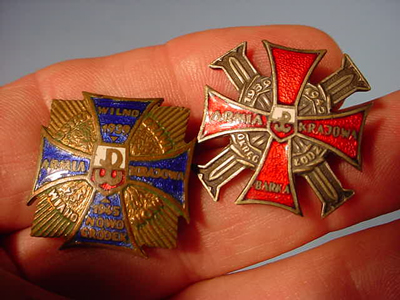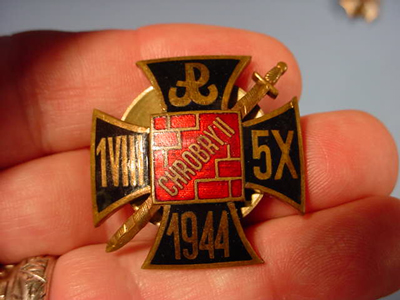|
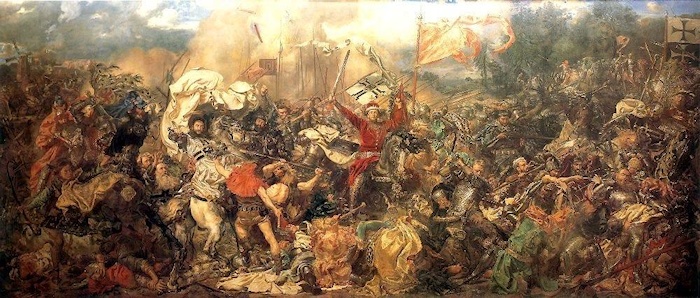
Painting of the Battle of Grunwald in the National Museum in Warsaw (Poland)
|
|
|
|
Battle of Grunwald (Bronze Plaque) (Item POL 1-6; BRONZE 2-10)
|
| DESCRIPTION: The Battle of Grunwald, otherwise known as the first Battle of Tannenberg, took place on July 15, 1410, between the Kingdom of Poland and the Grand Duchy of Lithuania on one side (estimated 39,000 troops) and the Teutonic Knights on the other (about 27, 000 )troops. In the battle, the Teutonic Order was defeated and never recovered its former influence. The depiction of the plaque supposedly illustrates the moment when Ulrich von Jungengen, the 21st Grand Master of the Teutonic Order (left) dressed in a tunic with a black cross is killed by infantry. Witold the Great, Grand Duke of Lithuania, who was postulated King of the Hussites, is shown in triumphant position (center). This defeat of the knights marked the rise of the Polish-Lithuanian Union as the dominant political and military force in the region. The battle was one of the largest battles in Medieval Europe and is regarded as the most important victory of Poland, and Lithuania. It always has been surrounded by romantic legends and nationalistic propaganda thus becoming a large symbol of struggle against invaders and a source of national pride. The plaque of sheet bronze is 17 x 8 1/4 inches. There is a small, hanging loop at the center top so it evidently was a wall decoration in a patriot’s home in Poland or Lithuania. But, we bought it from a widow of a German Waffen-SS soldier who brought it home after the 1939 Polish campaign of the German Army, so in essence it is ironic that this Teutonic soldier brought home this evidence of Polish vindictiveness and victory against his ancestors. This a really rare piece of Polish war memorabilia (great for militant Poles). Are there any of you out there?
PRICE: $350.00
|
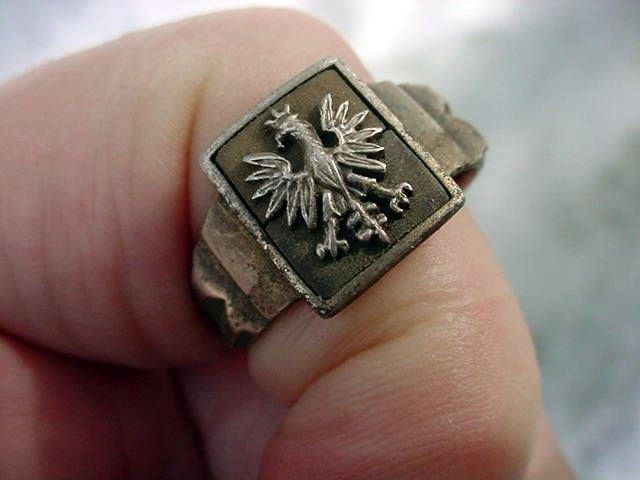
|

Standard of the Polish 1st Jäger Regiment
|
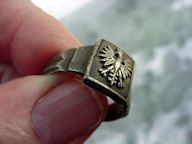
|
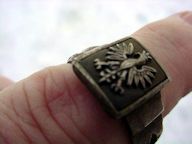
|
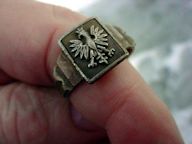
|
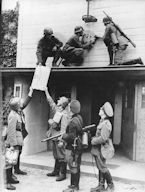
German soldiers remove the Polish white eagle symbol in 1939.
|
|
|
Old, Captured Polish Ring - (War Trophy) (Item POL 1-7; WEHR 33-21)
|
DESCRIPTION:
Here is a ring that bears the likeness of the white eagle of Poland which is the oldest of Poland’s national symbols and goes back to the formative period of Polish statehood. The crown on the head of the eagle is said to be the coronation crown of Swen Przemysl, Duke of Wielkopolska, who assumed the crown of Poland in Gniezno thus bringing about the reunification of the country and the golden crown of Poland’s symbol on the head of the eagle would represent the power of this king. The white eagle was adopted on June 26, 1295. The eagle and crown were lost when Poland lost its independence when it was partitioned in three stages by Russia, Prussia, and Austria in 1772, 1793, and 1795, respectively. The use of the white eagle was forbidden at that time, but the eagle was revived during the insurrections of 1830 and 1863 and it was instituted as the official state symbol in 1927. It is the one which continues in use to this day. However, during the Communist Soviet Regime the crown, considered a symbol of royal heritage, was injudiciously removed from the restored white eagle emblem. In 1989, when the solidarity movement caused the downfall of the Communist regime, one of the first acts of the new government was the restoration of the white eagle’s crown. The white eagle once was an emblem of absolute power of kings over the centuries and Polish people even today are thrilled to see it fly on the Polish national flags and banners, seals, coins, on soldier’s caps and uniform buttons. We German patriots, though, would appreciate it if it were not to be seen flying in our sacred Danzig, the ancestral home of the Teutonic Knights. If you don’t mind and even if you do we would like to tear down the city signs that proclaim “Gdansk” and put the proud word “Danzig” once more in its place. Be a Polish patriot if it suits you, but I am a “Germanophile.”
The Ring
This ring is definitely an old one crafted in genuine silver. Its eagle is clearly defined perched inside a relief square framing.
The shank or sides are fashioned in pure art deco motif. The size is about 10 ¼ and we have only one. I am sure that it predates WWII or is possibly even pre-WWI. It is far from being a souvenir ring. I am sure it is military and probably was the property of a Polish officer. It was bought in Germany from the widow of a German veteran who participated in the Polish Campaign of 1939, but the ring that was possibly surrendered dates in all probability earlier. This is unique and historically important.
PRICE: SOLD
|
|
|
|
Polish Medal for Sacrifice and Courage (Item POL 1-8)
|
| DESCRIPTION: The Medal for Sacrifice and Courage is a Polish medal established on February 17, 1960. It's awarded to those who, with disregard for their own life, save people from drowning, aid the victims of natural disasters, fires, explosions, or other unfortunate circumstances, or protect the property of others during such events. Jozef Goslawski designed the medal in 1960.
PRICE: $150.00
|
|
|
|
Polish War Order of Virtuti Militari (Item POL 1-9)
|
| DESCRIPTION: The War Order of Virtuti Militari (Latin: "For Military Virtue") is Poland’s highest military decoration for heroism and courage in the face of the enemy at war. It was created in 1792 by Polish King Stanislaus II Augustus, and is the oldest military decoration in the world still in use; last awarded 1989.
PRICE: $150.00
|
Contact Us
Please refer to item designator in parentheses in all correspondence.
Please E-mail for any additional information you may need.
If you prefer, contact 'Germania' at PO Box 68, Lakemont, GA 30552
or call at 706.782.1668.
Please! do not call during the wee hours of the morning. The best time for calling us is between 10am and 12 noon and between 9pm and 11 pm (eastern time).
|

![]()

